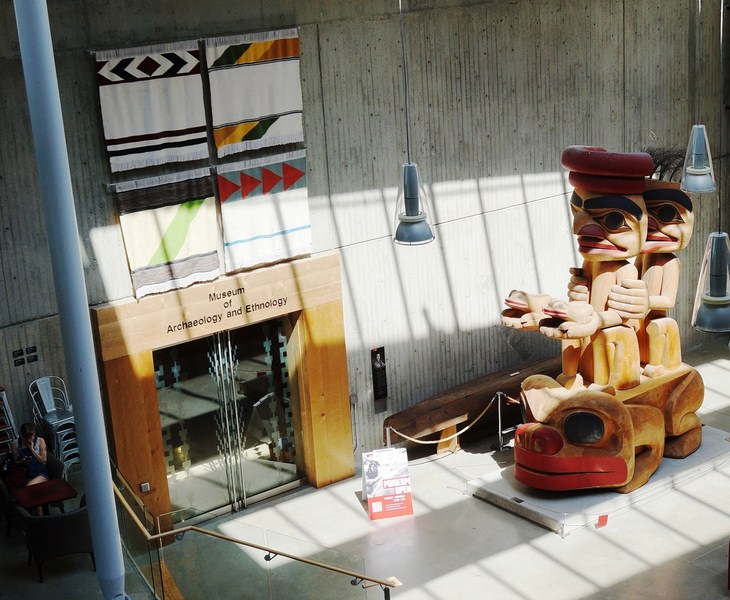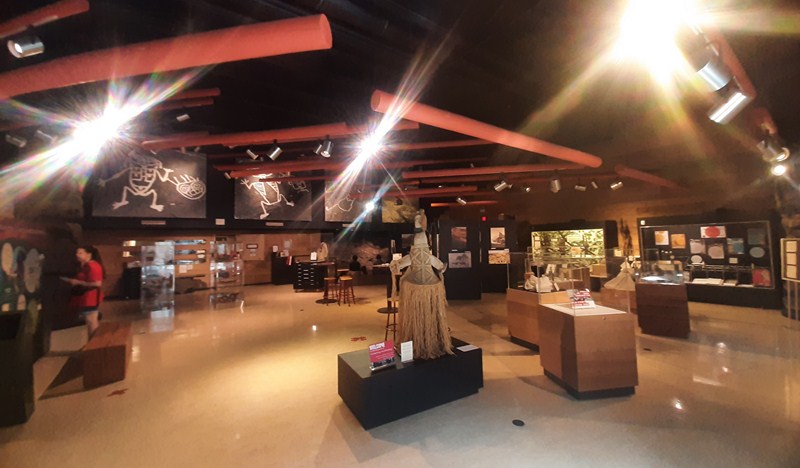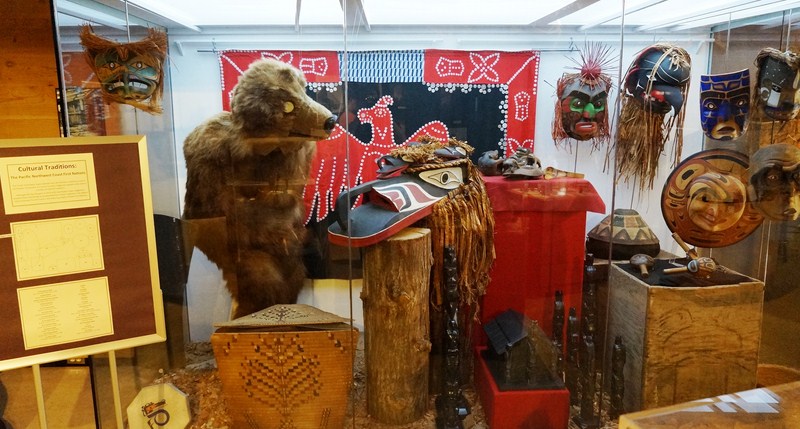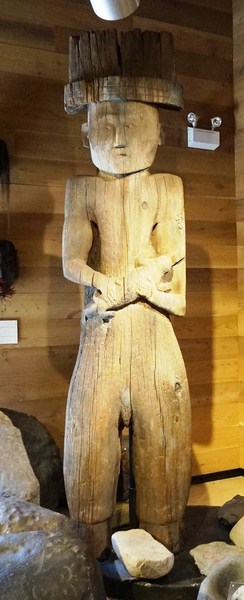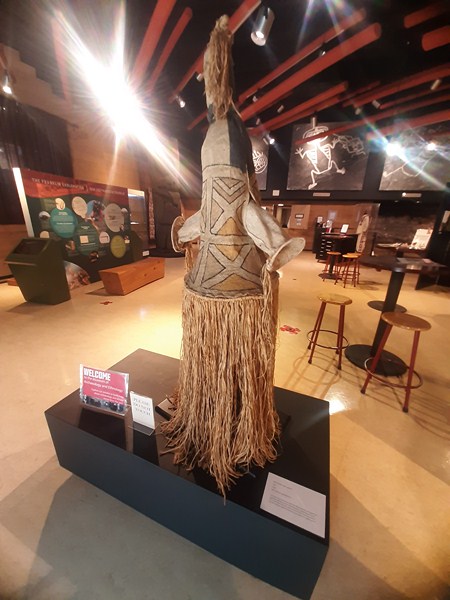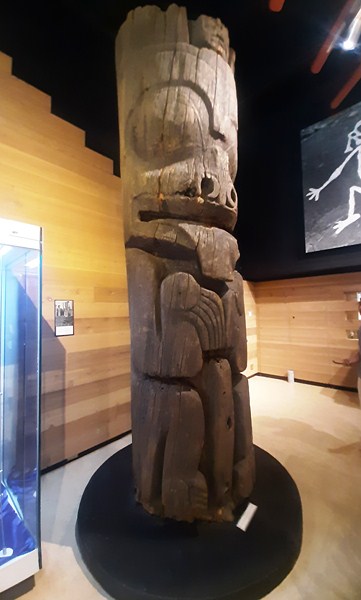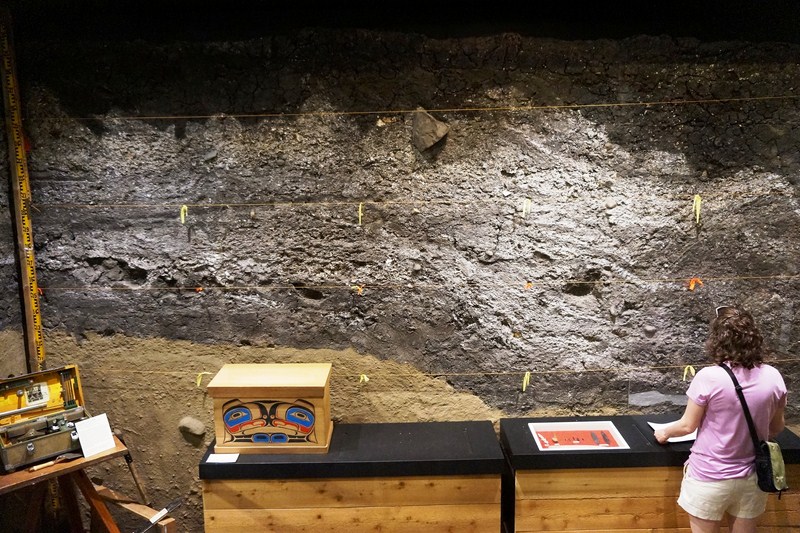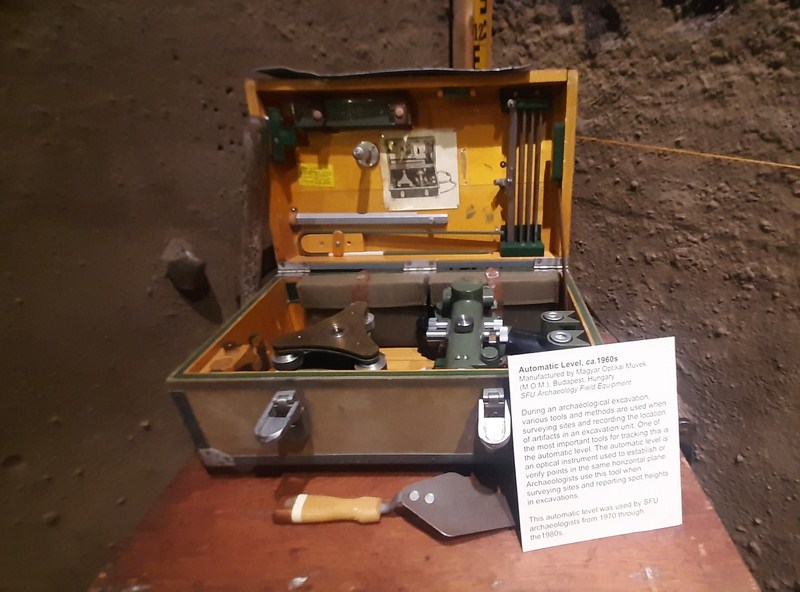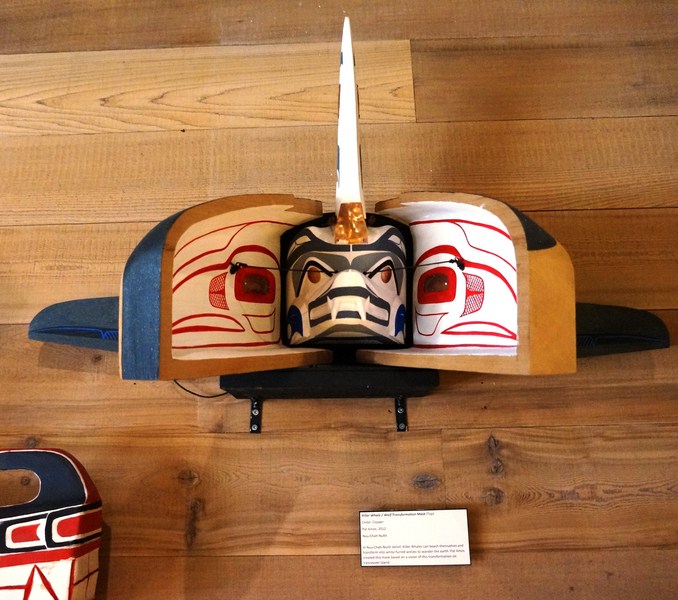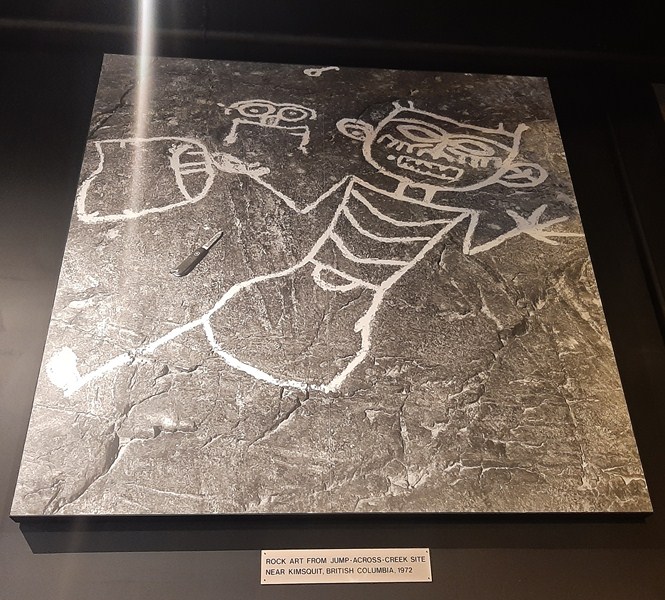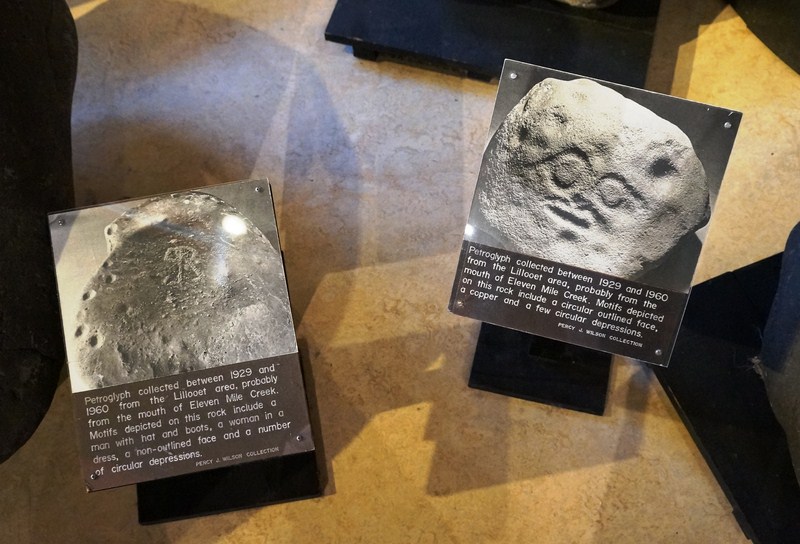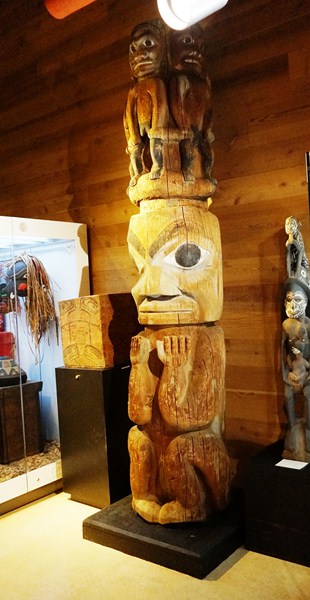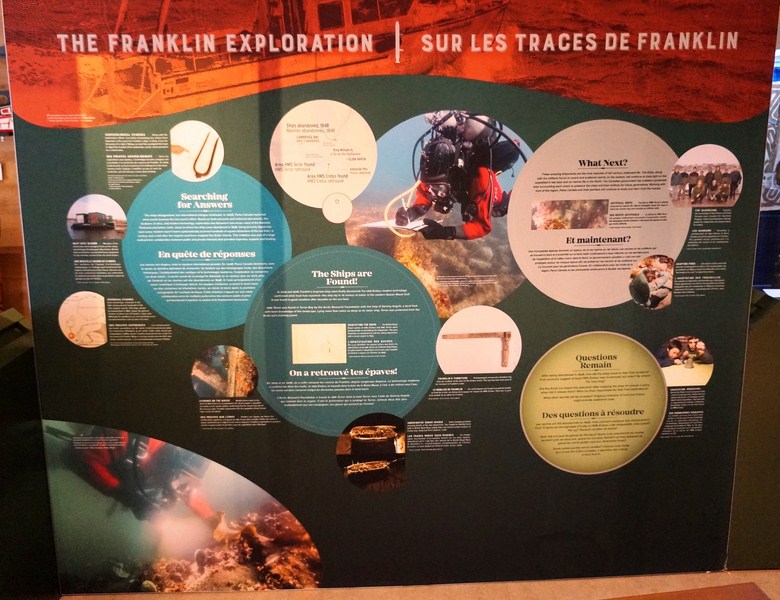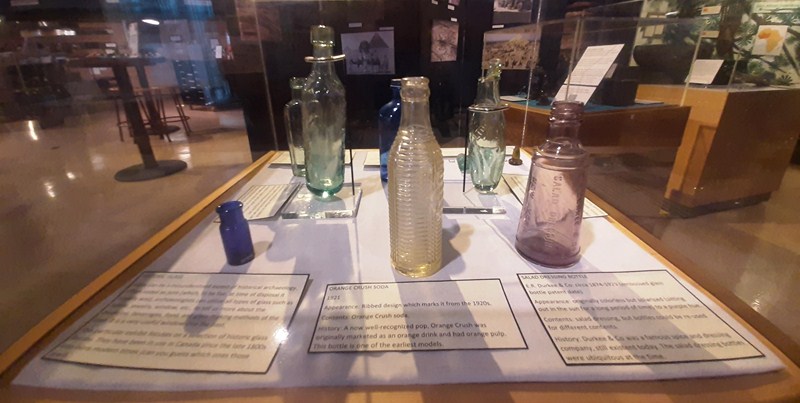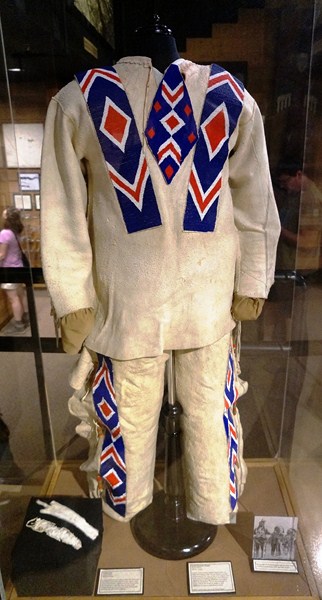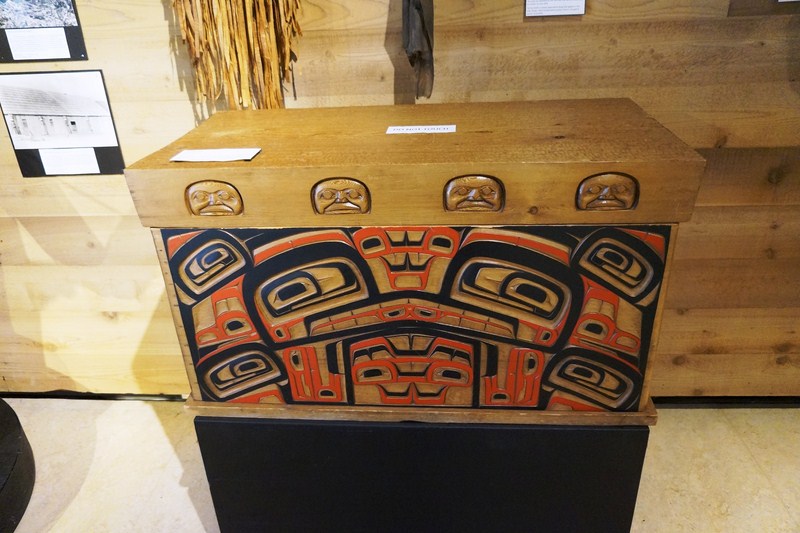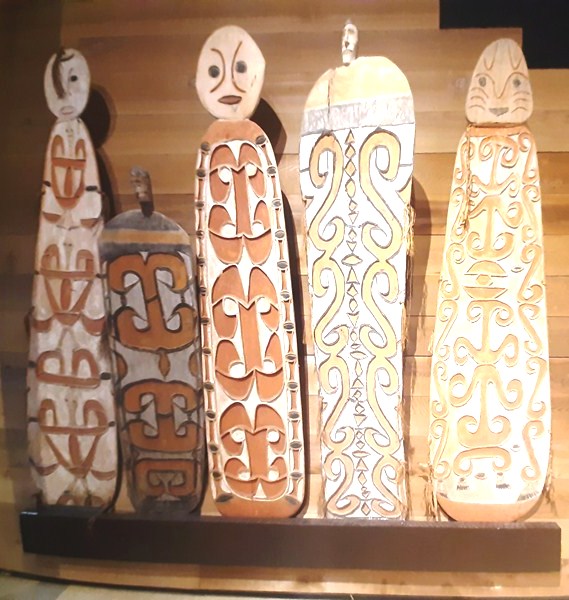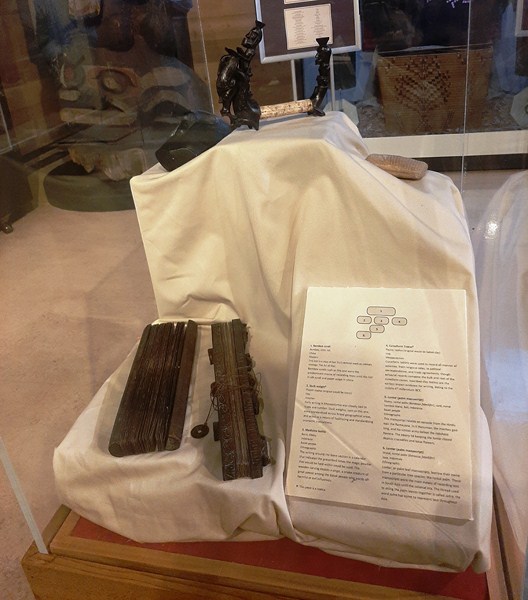On our 8th day in Vancouver, Jandy and I and decided to visit Simon Fraser University (SFU) and its Museum of Archaeology and Ethnology (MAE), From Holdom Station, we took the Millenium SkyTrain to Production Way Station where we boarded the No. 145 bus.
Upon alighting at the SFU transit loop, next to the Blusson Building (there was a big sign outside identifying it), we walked over to the nearby Saywell Building.
Entering the building, we noticed that finding the museum was a challenge which can be as much of an experience as exploring the museum itself.
We had to ask a student for directions. The museum was actually one floor below, in a courtyard beside the museum entrance. Taking the stairs down, we were greeted huge, wonderful wooden frog carving called Frog Constellation.
Carved in 2005 by Haida artist James Hart, a chief from Haida Gwaii, he is one of the most accomplished artists currently working in the Northwest Coast style. The carving is his tribute to a small shamanic piece carved by an unknown Haida artist on the Northwest coast in the 1870s.
The small but well-curated Simon Fraser University Museum of Archaeology and Ethnology (MAE) collects, researches, and exhibits archaeological and ethnological artifacts from around the world with a focus on British Columbia.
The MAE is closely affiliated with the Department of Archaeology at Simon Fraser University. Archaeological collections arising from excavations and other research by faculty, staff, and students are housed in the museum.
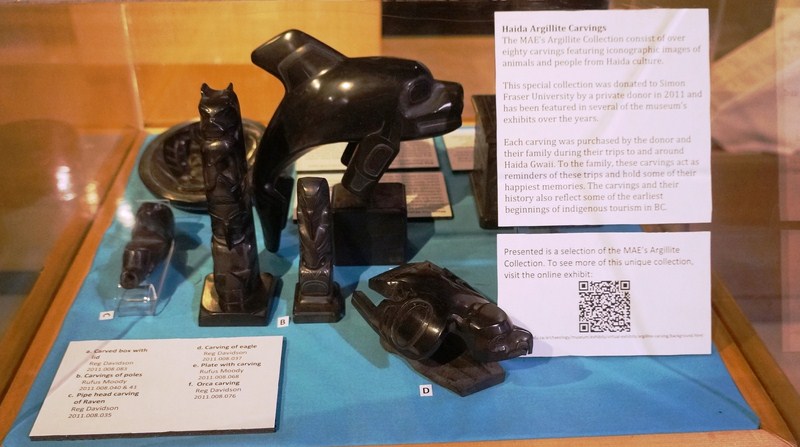
Argillite carvings, from prominent Haida artists, featuring iconographic images of animals and people from Haida culture. Displayed on totem poles, serving wear or as statues, they are part of a collection of over 80 pieces donated to the university by a private donor in 2011.
In scope or depth, this museum doesn’t compare to the anthropology museum at the University of British Columbia. On the other hand, it’s free (though you can make a donation). Though small, it was filled of information with artifacts explained in great detail. We probably spent an enjoyable 30-40 minutes or so in this gorgeous little museum.
The Northwest Coast Monumental Sculptures (“Totem Poles”) Exhibit displays monumental cedar sculptures from the northern, central and south coast of British Columbia, exhibited here through the generosity of the Royal BC Museum in Victoria, that illustrate the varied artistic traditions of the First Nations of the BC Coast. The centerpiece of the Museum’s collection is the giant aforementioned “Frog Constellation.”
Displays include First Nations carved poles, monumental sculptures illustrating the varied artistic traditions of the First Nations of the BC coast. There are also canoes, ceremonial regalia, woven baskets, etc.
The NAMU Profile: 9,700 Years of Human Occupation Exhibit, their most remarkable permanent exhibit, is a profile section of an excavation trench from the 1977 field school at the Namu site on the British Columbia central coast, an archaeological record that spans nearly 10,000 years.
The profile section that is on display in the museum represents about 5,000 years of cultural and natural accumulations. Evidence of nearly continuous use at the site has been found and separated into six general periods of use.
The profile on display shows Periods 2 (6000 BP – 5000 BP) through 5 (3500 BP – 2000 BP). Though the profile on display was removed in 1977, excavations at the site continued in 1978 and 1994; many of the artifacts from these excavations appear in more than just the Namu exhibit itself.
The Rock Art: Petroglyphs and Pictographs Exhibit includes the museum’s collection is rock art from the Lillooet area of BC. Looking up, we also found stunning photographs, taken in 1972 by Philip Hobler, of the Jump-Across-Creek rock art.
The photographs are complimented by the large carved stones, on display near the front door, which were collected between 1929 and 1960 from the Lillooet area, from the mouth of Eleven Mile Creek.
The designs were pecked or ground into the rock, either by a piece of sharp stone, by chiseling the rock using a hammerstone to deliver blows to a stone chisel, or by abrading the surface of the rock with a piece of harder stone. Motifs depicted on this rock include a number of faces, anthropomorphic figures and numerous lines and depressions.
The Cultural Traditions Exhibit displays objects that showcase the rich history, cultural traditions and enduring vitality of the indigenous First Nations living in the Pacific Northwest Coast which extends from the Northern California coast to the Alaskan Panhandle.
The Hunt and Gather: An Interactive Geocaching Activity, an interactive exhibition, incorporates objects and artifacts, museum displays and puzzles in a fun “treasure hunt” game meant to celebrate the diversity of the Museum’s collections. In addition to learning about Geocaching, this exhibit is a fun, informative and interactive way to explore the museum.
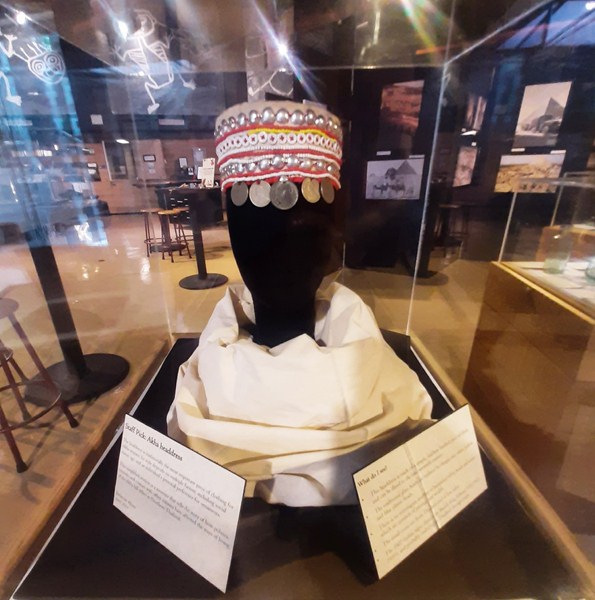
Headdress worn by women of the Akha hill tribes of Northern Thailand which is adorned with five coins (the Indian rupee in the middle is relatively valuable); red, white, blue and yellow plastic beads and aluminum-like balls. Stitching on the inside is done by machine.
The collection includes artifacts from around the world — masks from Africa; Indonesian shadow puppets; bamboo scrolls from Asia; spears and atlatls from various continents and periods of history; tiny Bolivian dolls and West Coast artifacts. Not a large collection but well worth the time to look at everything.
There were also a number of temporary exhibits. The “Into the World: A journey through the photographic collection of the SFU Museum of Archaeology & Ethnology” gives a glimpse into the fascinating world of archaeology and ethnology through the extensive photographic collection of our museum.

Into the World: A journey through the photographic collection of the SFU Museum of Archaeology & Ethnology
“The Franklin Exploration,” a bilingual travelling pop-up exhibit, from the Vancouver Maritime Museum, on the archaeology of the HMS Erebus and HMS Terror, was developed by Parks Canada and the ROM.
“Beyond The Mask: The Fluidity of the West African Experience,” created by Jazmin Hundal and Melissa Rollit, features eight out of the dozens of masks from the region of West Africa housed at the SFU Museum of Archaeology and Ethnology that stand out in their ability to convey something essential about the human experience.
“Canoes, Waterways, Lifeways” offer insights into the history of Pacific Northwest Coast canoes by showing how different styles were built and used in the various territories within the region. Sometimes, especially in the case of older styles, models are all we have to learn from.
“Historic Glass,” created by Kristen McLaughlin, focuses on a selection of historic glass bottles from the collections that have been in use in Canada since the late 1800s into more modern times. These tell us more about the medicine, beverages, food, and glass-making methods of the past.
“Aksum’s Treasures: Reminders of an Ancient Civilization,” created by Jurian ter Horst, uses contemporary photographs to tell the stories of the treasures (granite monoliths, several churches, etc.) in the ancient town of Aksum, Ethiopia
“Plains Regalia,” created by Tiinesha Begaye and Hilary Pennock for SFU’s 50th anniversary in 2015, is an exhibit of a magnificent Plains beaded costume purchased from an antique shop in Calgary in 1972 by Dr. Roy Carlson.
Hilary and Tiinesha cleaned the costume, repaired the beading, modified a mannequin to conservation standards, mounted the costume on the mannequin and wrote the interpretive text for the large display.
“Pacific Northwest Bentwood Boxes,” created by Dr. Barbara Winter, features often elaborately carved and painted Bentwood boxes and chests created by Northwest Coast artists which speaks to the cultural longevity of indigenous peoples of this area.
“Asmat Shields,” created by Sarah Fox and Jennifer Halliday, features shields, topped with an image of the ancestor the shield was created to represent, that were originally created for use in reprisal raids by the Asmat of Indonesia. Due to traditional headhunting practices being outlawed, the shields are now created as art pieces.
“Ancient Writing,” created by Duncan McLeod, showcases a collection of a variety of different texts from China, to Indonesia and the Middle East, offering insights of ancient cultures from the texts they left behind, in all their assorted forms.
Museum of Archaeology and Ethnology: Northeast corner of the Academic Quarter, Saywell Atrium, off Saywell Hall, 8888 University Drive, Simon Fraser University, Burnaby, British Columbia V5A 1S6. Tel: (778) 782-3325 and (778) 782-3135. E-mail: museum@sfu.ca. Website: www.sfu.ca/archaeology/museum.html. Admission is free. Open Tuesdays to Thursdays, 10 AM to 2 PM.
How to Get There:
By Public Transportation:
- #95 bus: From the Burrard Street SkyTrain Station downtown by way of Hastings Street
- #144 bus: From Metrotown Station
- #145 bus: From Production Way SkyTrain Station
- Millennium SkyTrain Line – get off at Production Way, then take #145 bus.
By Car:
- From Trans-Canada Highway (Highway 1) — take the Gaglardi Way Exit 37.
- From Lougheed Highway (Highway 7) — turn (north) onto Gaglardi Way.
- From Hastings Street (Highway 7A) going east — take the right lane exit onto Burnaby Mountain Parkway.
The closest parking lot to the museum is the North Parking Lot. It is paid parking.

